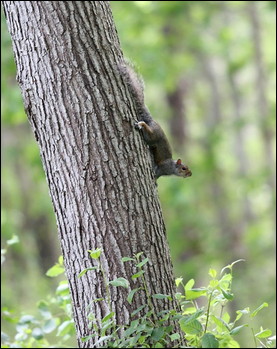 Squirrels can also carry ticks. |
Lyme disease has become one of the serious infections that too many people catch. And its range is enlarging. First identified in Lyme, Connecticut a few decades ago, it is now endemic and spreading across the US and Canada.
Spring to early summer is the most infectious time for the tiny, immature black ticks that transmit it. Each is just the size of a period in this article. They want blood to mature and lay their eggs. Any blood, including yours.
They crawl to a protected, often hidden, area on your skin and attach themselves. Then they suck for a couple of days, and transmit disease into your bloodstream.
What should one do to protect against Lyme disease? First, always apply mosquito repellant containing DEET to shoes, socks and pants before gardening or walking outdoors especially in grassy areas or woodlands. When you come home, always check to see if you have ticks on you. Especially children. And shower. Throw clothing in the dryer for 10 minutes to kill any in your clothes. They show up easier on light clothes.
Ticks need to be attached for at least 24 hours to transmit disease. If you find a tick that is enlarged and full of blood, call your doctor and get antibiotics to prevent infection. This is essential, for once full blown, the disease is hard to eradicate, and can become a debilitating, chronic problem.
Now for some scientific information. A well mowed lawn will have few ticks. If dry wood chips are used as mulch around the edges ticks will find it too hot and dry and won’t survive. (They need higher humidity.) If you have kids or a dog, mow low. And definitely put a tick preventative collar on your dog, or cat because you can get a tick bite from pets, even if you never go outside.
The most dangerous place is the yard/woodland edge, with tall grass and brush. On the edge of a path in open space, 60 ticks were picked up on a blanket pulled just 100 feet. Fields should be mowed 3 or 4 times a year to keep the tick population down.
However, the riskiest places are the small forest patches in suburban landscapes, which have tick populations much, much higher than fields, or even the woodland edges. Forests actually have the highest tick populations of anyplace.
Tick total ecology is far more complicated, starting with the size of the acorn crop (technically called "mast") and the weather in any year. Mouse populations explode, particularly the reclusive white-footed mouse, when there is a large "mast" year. Research is ongoing and complex.
Mild winters help produce a big population of ticks, who normally over-winter in the nests of mice and chipmunks. It is these animals that actually carry, perpetuate and spread tick diseases, but they don’t travel very far.
However, other animals spread the ticks from the limited range of each mouse or chipmunk. These are squirrels, raccoons, foxes and skunks among others, in addition to deer. (Their blood is also good tick food.)
There are a few myths also. A mild climate is needed for tick survival. Not true. Only deer determine tick populations. Actually it involves many animals. The forest edges are dangerous but the forest is safe. Also not true.
And whatever you believe, don’t rely on "organic" or natural repellants. I actually spray the outside of my work boots with the pesticide, pyrethrum which lasts for about a month. But it should never, never be put on the skin. The bottom line is – always check for ticks and seek antibiotics when bitten.
Ruth S. Foster is a landscape consultant and arborist. More gardening
information can be found on her website www.mothersgarden.net.
Credit: www.mothersgarden.net




























